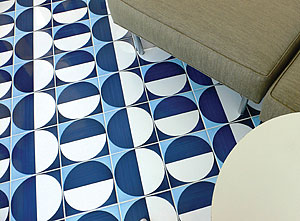
For a private residence in Montauk, NY, custom floor
tile made by Italian manufacturer Bardelli was employed for the master bedroom and writing studio. The
tile was a replica of floor tile found in a hotel in Sorrento, Italy, designed
by renowned architect Gio Ponti. Architect: Pentagram, New York, NY;
Tile Manufacturer: Bardelli, Italy; Tile Distributor: Hastings Tile and Bath,
New York, NY; Installation Products: Mapei Corp., Deerfield Beach, FL
When the architectural team at Pentagram in New York, NY, designed a private residence in Montauk, NY, a personal trip taken years ago by firm partner, James Biber, FAIA (currently of Biber Architects in New York, NY), was a key part of its inspiration. The architect sought to employ the same floor tiles that he saw in a Sorrento, Italy, hotel that was designed by famous Italian architect Gio Ponti.
“This house is by the Atlantic Ocean, so it’s a fairly brutal environment,” he said. “The entire house, especially the floors, was built to take decades of abuse.”
Featuring radiant floor heating throughout the residence, porcelain tile can be found in a large portion of the home, including the master bedroom and writing studio. “When it came time to look at floor tile, it really, in the end, defined the rooms,” said Biber. “The house was designed to feel like fairly open spaces. We wanted the floor pattern to be rather continuous.”
During the selection process, the architect was influenced by a trip he had taken to Italy years ago. “I stayed in a hotel in Sorrento that Gio Ponti designed,” he said. “There’s also one in Rome. I remember our room very well. It was overlooking the Amalfi Coast with a great balcony. The [floor tile] had this pattern of different colors of blue and white. The hall had Gio Ponti couches, and all of the doors were open to the other rooms. All of the rooms had different floor tiles with the same color but different patterns.
“When it came time for this project, I really thought about that [hotel experience],” Biber went on to say. “Montauk is, of course, not off of the Amalfi Coast, but it really feels like the shore, so I found some old photographs - literally, snapshots I had taken. We didn’t know who made the floor tile. The hotel in Rome used a similar idea, but the color palette was different. We had the tile visually, but no indication of where it was made or who made it.”
Biber further explained that Pentagram has used a fair amount of custom tile in
its work, so the design team started its search with tile companies the firm
had already worked with. “We showed the tile, color palette and how we wanted
it to look,” said Biber. “Samples of it weren’t even close. We had close to 25
samples. Literally, as a last resort, one of our staff members went around the
corner to Hastings Tile [and Bath of New York, NY], and the woman there said
she could probably get it done. They sent it to Italy, and the sample came back
absolutely perfect.”

“The tiles are very dynamic, like ripples in the ocean,”
said James Biber, FAIA (currently of Biber Architects in New York, NY), adding
that the project received First Prize in the Residential Architecture &
Design category for Ceramic Tiles of Italy’s 2010 design competition.
Both the master bedroom and writing studio, which together measure around 1,000 square feet, feature two different floor patterns of the 20- x 20-cm tiles. A pattern of half circles can be found in the writing studio, while an “inter-packing” pattern was selected for the master bedroom - extending into the master bath.
“The tiles are very dynamic, like ripples in the ocean,” said Biber. “What’s interesting to me is I’m glad they don’t keep the tile as a stock item. It’s really a special tile, and we’ve done a lot of tile and a lot of custom tile. I think this is one of the most successful examples.”
According to the architect, the homeowner was very receptive to the idea. “Once we agreed to do it, it was pretty automatic,” he said. “It was a perfect idea because the owner had a collection of vintage furniture and knew who Gio Ponti was. We just had to find someone to make a faithful reproduction.
“It was a fairly easy process after we made a decision and finally found a manufacturer,” he continued, adding that the tiles went through a smooth installation process using products from Mapei Corp. of Deerfield Beach, FL. “We spend a lot of time on site. It was mostly my associate, Mike Bonner. This is a very persnickety house. [The client was] very concerned about the precision of everything. It was important that we dimensioned everything to the tile size.”
Because of its location, the entire project, which includes a home and guest house, took five years to complete. “Since it’s on an oceanfront, there are a lot of environmental and local regulations,” Biber explained. “A lot of time was spent getting approval.”
Pentagram was honored with First Prize in the Residential Architecture & Design category for Ceramic Tiles of Italy’s 2010 design competition. The project has also been recognized by the American Institute of Architects (AIA). “Both the main and guest houses won New York State AIA awards of some kind,” said Biber.








